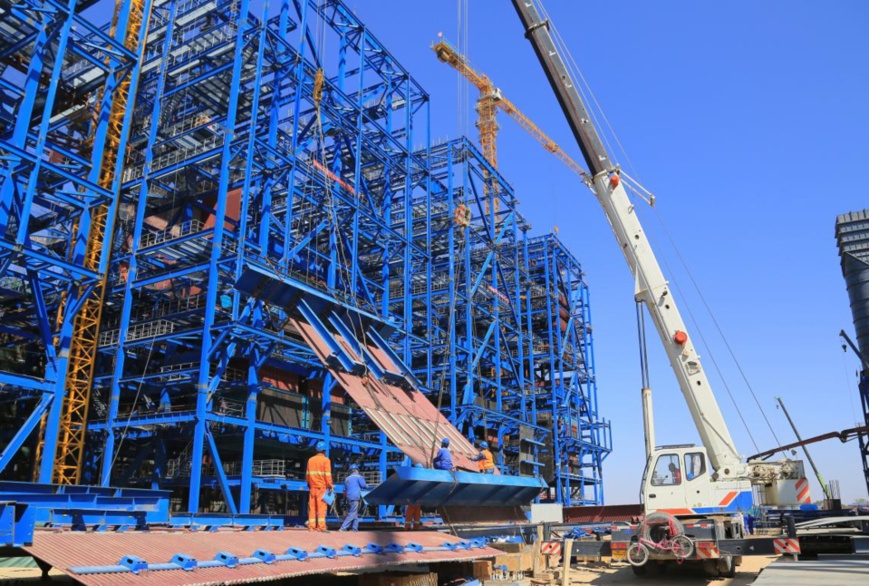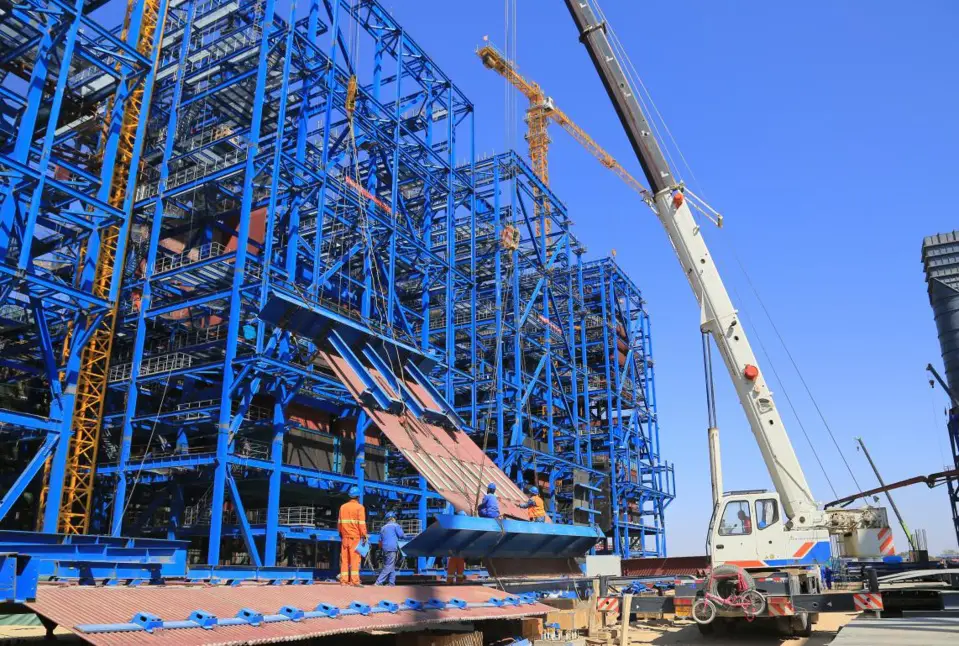By Chen Feiyu, Zhang Cheng, People's Daily

Photo taken on April 27, 2020, shows the construction site of a coal-to-ethylene glycol project of Jiutai New Material Co., Ltd. in north China's Inner Mongolia autonomous region. (Photo by Ma Bin/People's Daily Online)
North China's Inner Mongolia autonomous region, a key coal-producing region as well as energy and chemical industry base in the county, is pursuing a path of green development empowered by science and technology.
The Buertai coal mine in Ordos city of Inner Mongolia, a coal mine belonging to Shenhua Shendong Coal Group Co., Ltd., one of the subsidiaries of China’s largest coal miner Shenhua Group Corp., has realized automatic coal cutting. Thanks to its intelligent facilities, workers of the mine only need to monitor the operation of coal cutters when these automated machines cut coal at coalfaces 360 meters underground.
Intelligent mining is an important part in the construction of green mines, said Zhao Chunguang, head of a mining team at Buertai.
By employing more scientific mining methods and digitalizing management information, Buertai coal mine aims to improve the comprehensive utilization efficiency of resources and cut down waste of coal resources, Zhao noted.
In 2020, 15 mines in Inner Mongolia were included into China's green mine list.
So far, the autonomous region has constructed 381 green mines, among which 67 have been included into the country’s list of green mines, making Inner Mongolia a leading region in the country in terms of the number of green mines.
Last year, various areas of Inner Mongolia speeded up the construction of projects concerning renewable sources of energy.
In Xilingol League of the autonomous region, wind power plants with a combined installed capacity of nearly 7 million kW were completed and connected to the power grid, while Tongliao city of the region began the construction of a large-scale ground-breaking project that integrates thermal, wind, and solar-power facilities.
Today, the installed capacity of renewable energy accounts for 36 percent of the total installed power generation capacity of the region.
With enormous grasslands and forests as well as many rivers and lakes, Inner Mongolia is an ecological function zone with the largest area and the most species in northern China, and represents a significant part of China’s natural resources.
While pursuing high-quality growth, Inner Mongolia also prioritizes the construction of ecological civilization.
Xilingol League has stopped approving new projects for coal production, and intends to shut down existing coal mines in grassland core areas in an orderly manner.
Inner Mongolia will make the protection of prairies, large forests and wetlands main tasks in eastern areas, shut down all coal mines in nature reserves, and ensure that coal mines, wind power, and photovoltaic projects will be closed in due course in grassland core areas, and that no new project for coal mines will be launched in grasslands, according to Zhang Yongjun, an official with the development and reform commission of Inner Mongolia.
By taking a series of measures, such as cutting the number of sheep, replacing sheep with cattle, balancing grasslands and the number of livestock, and grazing management of animals, Inner Mongolia has effectively restored its vast stretches of grasslands.
The average vegetation coverage of pastures in Inner Mongolia reached 44 percent in 2020, up 4 percentage points from 2012.
So far, the autonomous region has generally curbed grassland ecological degradation and significantly improved the ecology in key ecological rehabilitation areas.
In the past five years, Inner Mongolia completed ecological rehabilitation tasks in over 10 million mu (about 0.7 million hectares) of forests and 30 million mu of grasslands every year, becoming a national leader in promoting ecological restoration.
Meanwhile, the region prevented and controlled desertification on an average area of 12 million mu every year, which accounted for about 40 percent of China's annual total.
The Buertai coal mine in Ordos city of Inner Mongolia, a coal mine belonging to Shenhua Shendong Coal Group Co., Ltd., one of the subsidiaries of China’s largest coal miner Shenhua Group Corp., has realized automatic coal cutting. Thanks to its intelligent facilities, workers of the mine only need to monitor the operation of coal cutters when these automated machines cut coal at coalfaces 360 meters underground.
Intelligent mining is an important part in the construction of green mines, said Zhao Chunguang, head of a mining team at Buertai.
By employing more scientific mining methods and digitalizing management information, Buertai coal mine aims to improve the comprehensive utilization efficiency of resources and cut down waste of coal resources, Zhao noted.
In 2020, 15 mines in Inner Mongolia were included into China's green mine list.
So far, the autonomous region has constructed 381 green mines, among which 67 have been included into the country’s list of green mines, making Inner Mongolia a leading region in the country in terms of the number of green mines.
Last year, various areas of Inner Mongolia speeded up the construction of projects concerning renewable sources of energy.
In Xilingol League of the autonomous region, wind power plants with a combined installed capacity of nearly 7 million kW were completed and connected to the power grid, while Tongliao city of the region began the construction of a large-scale ground-breaking project that integrates thermal, wind, and solar-power facilities.
Today, the installed capacity of renewable energy accounts for 36 percent of the total installed power generation capacity of the region.
With enormous grasslands and forests as well as many rivers and lakes, Inner Mongolia is an ecological function zone with the largest area and the most species in northern China, and represents a significant part of China’s natural resources.
While pursuing high-quality growth, Inner Mongolia also prioritizes the construction of ecological civilization.
Xilingol League has stopped approving new projects for coal production, and intends to shut down existing coal mines in grassland core areas in an orderly manner.
Inner Mongolia will make the protection of prairies, large forests and wetlands main tasks in eastern areas, shut down all coal mines in nature reserves, and ensure that coal mines, wind power, and photovoltaic projects will be closed in due course in grassland core areas, and that no new project for coal mines will be launched in grasslands, according to Zhang Yongjun, an official with the development and reform commission of Inner Mongolia.
By taking a series of measures, such as cutting the number of sheep, replacing sheep with cattle, balancing grasslands and the number of livestock, and grazing management of animals, Inner Mongolia has effectively restored its vast stretches of grasslands.
The average vegetation coverage of pastures in Inner Mongolia reached 44 percent in 2020, up 4 percentage points from 2012.
So far, the autonomous region has generally curbed grassland ecological degradation and significantly improved the ecology in key ecological rehabilitation areas.
In the past five years, Inner Mongolia completed ecological rehabilitation tasks in over 10 million mu (about 0.7 million hectares) of forests and 30 million mu of grasslands every year, becoming a national leader in promoting ecological restoration.
Meanwhile, the region prevented and controlled desertification on an average area of 12 million mu every year, which accounted for about 40 percent of China's annual total.
 Menu
Menu
 North China's Inner Mongolia sees notable achievements in green development
North China's Inner Mongolia sees notable achievements in green development
















